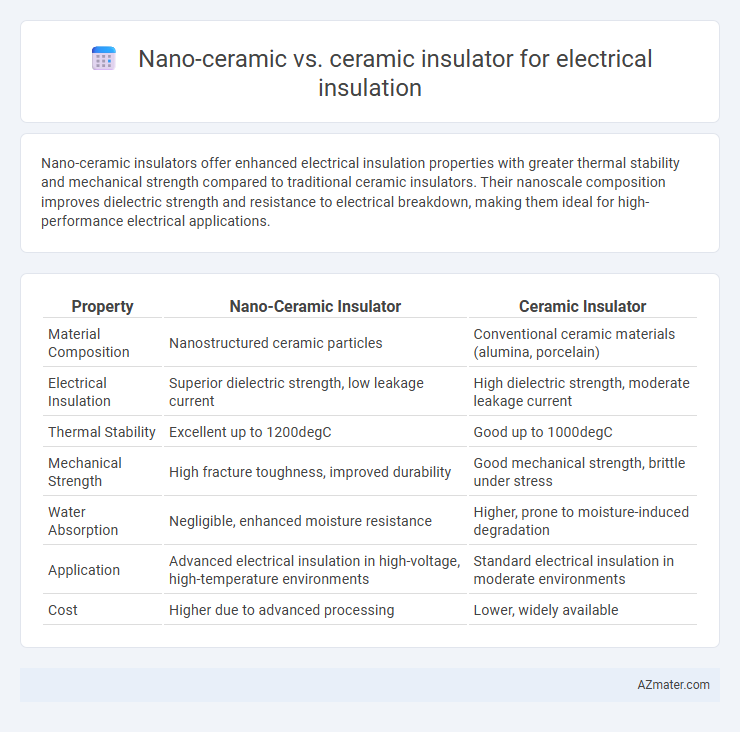Nano-ceramic insulators offer enhanced electrical insulation properties with greater thermal stability and mechanical strength compared to traditional ceramic insulators. Their nanoscale composition improves dielectric strength and resistance to electrical breakdown, making them ideal for high-performance electrical applications.
Table of Comparison
| Property | Nano-Ceramic Insulator | Ceramic Insulator |
|---|---|---|
| Material Composition | Nanostructured ceramic particles | Conventional ceramic materials (alumina, porcelain) |
| Electrical Insulation | Superior dielectric strength, low leakage current | High dielectric strength, moderate leakage current |
| Thermal Stability | Excellent up to 1200degC | Good up to 1000degC |
| Mechanical Strength | High fracture toughness, improved durability | Good mechanical strength, brittle under stress |
| Water Absorption | Negligible, enhanced moisture resistance | Higher, prone to moisture-induced degradation |
| Application | Advanced electrical insulation in high-voltage, high-temperature environments | Standard electrical insulation in moderate environments |
| Cost | Higher due to advanced processing | Lower, widely available |
Introduction to Electrical Insulation Materials
Nano-ceramic insulators offer enhanced electrical insulation properties compared to traditional ceramic insulators due to their finer microstructure and improved thermal stability. These materials provide superior dielectric strength, reduced leakage current, and better resistance to high voltage stress. Advances in nano-ceramic technology enable more reliable performance in high-voltage applications where durability and insulation efficiency are critical.
What Are Ceramic Insulators?
Ceramic insulators are electrical components made from alumina (Al2O3) or similar materials, designed to prevent electrical current from flowing to undesired paths by providing high dielectric strength and thermal stability. Nano-ceramic insulators enhance traditional ceramics by incorporating nanoscale particles, improving properties such as mechanical strength, resistance to thermal shock, and electrical insulation performance. These materials are widely used in high-voltage applications, ensuring reliable insulation in substations, power lines, and electronic devices.
Defining Nano-Ceramic Insulators
Nano-ceramic insulators incorporate nanoparticles within the ceramic matrix, enhancing electrical insulation properties by improving dielectric strength and thermal stability compared to traditional ceramic insulators. These materials exhibit superior resistance to electrical breakdown and better performance in high-frequency and high-voltage applications due to their refined microstructure and reduced porosity. Nano-ceramic insulators are increasingly favored in modern electrical systems for applications requiring compact size with enhanced insulation reliability.
Key Properties of Traditional Ceramic Insulators
Traditional ceramic insulators, commonly made from alumina and silicon dioxide, exhibit high dielectric strength and excellent thermal stability, making them ideal for electrical insulation applications. Their low electrical conductivity and resistance to environmental factors such as moisture and corrosion ensure long-term reliability in power transmission systems. These materials also provide mechanical robustness and resistance to thermal shock, critical for maintaining performance in demanding electrical environments.
Advanced Features of Nano-Ceramic Insulators
Nano-ceramic insulators exhibit superior dielectric strength and enhanced thermal stability compared to conventional ceramic insulators, making them ideal for high-voltage applications. Their nanostructured composition improves resistance to electrical discharge and surface contamination, resulting in longer service life and reduced maintenance costs. Advanced features include exceptional mechanical toughness and excellent hydrophobic properties, which significantly improve performance in harsh environmental conditions.
Comparative Electrical Performance
Nano-ceramic insulators exhibit superior electrical performance compared to traditional ceramic insulators, primarily due to their enhanced dielectric strength and lower dielectric loss, which ensures higher efficiency in insulating applications. The nano-scale fillers in nano-ceramics improve resistance to electrical breakdown and reduce surface leakage currents, making them ideal for high-voltage environments. In contrast, conventional ceramic insulators, while durable, generally have higher dielectric losses and lower resistance to partial discharge, limiting their effectiveness in advanced electrical insulation systems.
Durability and Lifespan Analysis
Nano-ceramic insulators exhibit superior durability and extended lifespan compared to traditional ceramic insulators due to their enhanced mechanical strength and resistance to micro-cracking. The nano-scale ceramic particles in nano-ceramic insulators provide better thermal stability and improved resistance to environmental degradation such as pollution and moisture ingress. These properties result in reduced maintenance costs and longer service intervals in high-voltage electrical insulation applications.
Cost and Manufacturing Considerations
Nano-ceramic insulators often feature superior mechanical strength and thermal stability compared to traditional ceramic insulators, but their manufacturing processes involve higher costs due to advanced materials and precision techniques. Ceramic insulators benefit from well-established, cost-effective production methods leveraging abundant raw materials, making them economically favorable for large-scale applications. The cost-benefit analysis of nano-ceramic versus ceramic insulators hinges on balancing enhanced performance with initial manufacturing expenses and overall lifecycle efficiency.
Industrial Applications and Use Cases
Nano-ceramic insulators exhibit enhanced dielectric strength and thermal stability compared to traditional ceramic insulators, making them ideal for high-voltage industrial applications such as power transformers and switchgear. Their nano-scale fillers improve mechanical toughness and resistance to electrical breakdown, optimizing performance in harsh environments like oil refineries and manufacturing plants. Ceramic insulators remain cost-effective solutions for standard electrical insulation tasks but are often limited by lower fracture toughness and susceptibility to thermal shock in demanding industrial use cases.
Future Trends in Electrical Insulation Technology
Nano-ceramic insulators offer enhanced dielectric strength and thermal stability compared to traditional ceramic insulators, enabling more compact and efficient electrical systems. Future trends in electrical insulation technology emphasize nano-ceramics for their superior resistance to electrical degradation and environmental stress, supporting the development of high-voltage power grids and advanced electronic devices. Advancements in nanostructured materials are driving improvements in mechanical robustness and longevity, positioning nano-ceramic insulators as a key innovation for sustainable and high-performance electrical insulation solutions.

Infographic: Nano-ceramic vs Ceramic insulator for Electrical Insulation
 azmater.com
azmater.com